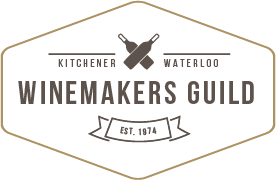Getting ready
Ensure that you have equipment cleaned and supplies on hand. Ensure that all equipment is sanitized.
Equipment – crusher/destemmer, wine press, primary fermenter, carboys, air locks, hydrometer, siphoning hose, funnel
Supplies – yeast, Go ferm, Fermade, Pectic enzyme, Cinnfree, Opti Red/White, SO2, Acidex, chromatography test kit, acid test kit, Lysozyme.
Determine style of wine desired – may depend on grapes received
Buy best grapes available – crush and de-stem as soon after picking as possible
Crush and Destem
Crush and destem grapes
Add enzymes (pectic (pec5l), cinn-free)
Add SO2 (25ppm) ¼ teaspoon/pail – 1-2 hrs after adding enzymes
Check for brix, Ph and acid levels
Adjust if needed (Adjust before fermentation)
Add 11g/lt sugar to increase brix by 1 (20-24 for whites will give 10.5 to 13% alcohol)
PH looking for 3.0 – 3.6 range
TA for reds, looking for 6. – 7.5 initially for reds (malo and cold stabilization will drop 1g/lt)
TA for whites, looking for 6.5 – 9 depending on wine style
Use tartaric acid to increases 1g/lt will raise TA 1
Use acidex or comparable to reduce acid. Use table to calculate volume of acidex and wine
Press grapes
Add 5g bentonite rehydrated (dissolved) in 50ml of hot water and place juice in a cold area 0-5C for 36-48hr to let juice settle.
Rack off sludge and warm clear juice to 15-18C. Put sludge into fridge to settle even more and reclaim clean wine as it settles adding to fermenting wine. Your must should be as clear as possible to start with.
Fermentation
Determine what you want finished product to be like in terms of alcohol level and acid/sugar balance
Select yeast strain best suited to desired finished product.
Use a primary fermentation vessel with lid or air lock to ensure that a blanket of CO2 covers the must.
Keep oxygen away from must as much as possible. When fermenting, the must generates CO2 protecting it from oxygen.
Prepare a yeast starter
Begin yeast culture (5g yeast/carboy, 5g GoFerm in 10 times its weight in 40`C H2O)
Wait until water reaches 37.5`C, add yeast culture and wait 15 min. Add 30ml juice@20`C (double volume). Add 60 ml of juice (doubling vol. & time until you reach 10% volume of total to ferment) now have 120 ml. Wait 1 hr and add 120 ml juice to culture (now you have 240 ml culture/juice). Wait 1 hrs & add 240 ml juice (now at 480ml). Wait 1 hrs & add 480 ml of juice (now at 960). Wait 1 hrs and add to wine bulk (this process ensures healthy yeast cell to start with) the starter should be the same temperature as the bulk must.
Add Opti-white if desired
Monitor temperature. Juice should be 18-20C to get it started well but then reduce temperature to 12-14C. Ferment in a cool area (12-14C) to maintain fruit and aroma. Fermentation will take a longer period of time to ferment in the cooler temperature. Monitor SG level as it ferments. When getting down to desired SG (depends on acid level). If a dry wine is desired move wine into a warmer area when SG reaches . 10 to finish fermenting down to .992-.994.
24 hours after fermentation is going feed with 3-4gr of fermaid per 20lt to must. At the 48hr mark add another 1-3gr/20lt of fermaid. The fermaid provides nitrogen for the yeast. Fermaid will only work in the first 1/3 of fermentation.
At ½ to 2/3 way through fermentation (approx. SG1040) add 5g DAP. If Hydrogen sulphide (rotten eggs) H2S noticed double amount of DAP.
If you want to stop fermentation, prior to dry and make an off dry wine (SG1.05 -1.0+ or –taste and balance) add SO2 (70ppm) and sorbate or bensoite (8.8g/20lt). If you are going to stop fermentation make sure starting brix is at a level to give you the alcohol level desired. To stabilize wine add SO2 and then cool to 1C. Rack off of gross lees
Another way of making an off dry wine, is to ferment to dry and then back sweeten to desired level. Ensure that wine is stabilized (all yeast is dead and removed.)
Finishing wine
Optional -Add Lysozyme to prevent malolactic fermentation if you have malo culture in the air and allow it to work 1 week before adding bentonite. Lysozyme will kill malolactic bacteria. Lysozyme will be stripped out of the wine by using bentonite.
Once wine is stabilized and fermentation is complete use a fining agent to clear wine.
There are several methods of fining white wine.
Using bentonite 5gr dissolved in 50ml of hot water is a good starting point. Allow to cool and add to wine. The use of casein or sparkaloid can also be used with bentonite to clear wine.
Let sit and clear in a cold area (0-5C) (Cold stabilization) for 4 weeks. This should provide a clear wine that has dropped its tartaric acid.
Rack off sediment.
Balance wine (acid to sweetness)
Stir vigorously in carboy to release CO2 before filtering. (Degassing)
Check for proper SO2 levels before filtering wine using at least two stages of filters. Sterile filtering is best and safest in preventing refermentation in the bottle.
Bottling and label
Cleanliness throughout the process (cleaning all equipment be using) will help prevent bacterial faults
Starting with the best quality grapes makes it much easier to make great wine.
Prepared by
Steve McDonald

